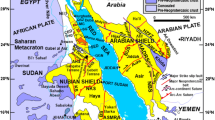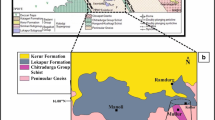Abstract
After a few years of research, the observation and the analysis of the deep-seated landslides suggest that these are mainly controlled by tectonic structures, which play a dominant role in the deformation of massif slopes. The La Clapière deep-seated landslide (Argentera Mercantour massif) is embedded in a deep-seated gravitational slope deformation affecting the entire slope, and characterized by specific landforms (trenches, scarps…). Onsite, the tangential displacement direction of the trenches and the scarps are controlled by the tectonic structures. The reactivation of the inherited fault in gravitational faults create a gouge material exposed to an additional mechanical and chemical weathering as well as an increased of leaching. The displacement of these reactivated faults gets increasingly important around the area of the La Clapière landslide and this since 3.6 ka BP. In this study, mechanical analysis and grain size distributions were performed and these data were analysed according to their proximity the La Clapiere landslide and times of initiation of the landslide by 10Be dating. Triaxial test results show that the effective cohesion decreases and the effective angle of internal friction increases from the unweathered area to the weathered area. The whole distribution of the grain size indicates that the further the shear zone is open or developed, the further the residual material loses its finest particles. This paper suggests that the mechanical evolution along the reactivated fault is influenced by the leaching processes. For the first time, we can extract from these data temporal behaviour of the two main mechanical parameters (cohesion and angle of internal friction) from the beginning of the La Clapiere landslide initiation (3.6 ka BP) to now.









Similar content being viewed by others
References
Agliardi F, Crosta GB, Zanchi A (2001) Structural constraints on deep-seated slope deformation kinematics. Eng Geol 59:83–102
Arel E, Tugrul A (2001) Weathering and its relation to geomechanical properties of Cavusbasi granitic rocks in northwestern Turkey. Bull Eng Geol Environ 60:123–133
Bogdanoff S (1986) Evolution de la partie occidentale du massif cristallin externe de l’Argentera. Place dans l’arc alpin. Géologie de la France 4:433–453
Bigot-Cormier F, Braucher R, Bourlès D, Guglielmi Y, Dubar M, Stéphan JF (2005) Chronological constraints on processes leading to large active landslides. Earth Planet Sci Lett 235:141–150
Binet S (2006) L’hydrochimie, marqueur de l’évolution a long terme des versants montagneux fractures vers de grands mouvements de terrain. PhD Thesis 190
Borrelli L, Greco R, Gullà G (2007) Weathering grade of rock masses as a predisposing factor to slope instabilities: reconnaissance and control procedures. Geomorpholy 87:158–175
Cappa F, Guglielmi Y, Soukatchoff VM, Mudry J, Bertrand C, Charmoille A (2004) Hydromechanical modeling of a large moving rock slope inferred from slope levelling coupled to spring long-term hydrochemical monitoring: example of the La Clapiere landslide (Southern Alps, France). J Hydrol 291:67–90
Cascini L, Critelli S, Di Nocera S, Gullà G, Matano F (1992) Weathering grades and landslides in the gneisses of Sila Massif: the case of S. Pietro in Guarano (Cosenza) (in Italian). Geol Appl Idrogeol 27:49–76
Casson B, Delacourt C, Baratoux D, Allemand (2003) Seventeen years of the “la Clapiere” landslide evolution analysed from ortho-rectified aerial photographs. Eng Geol 68:123–139
Chan Tien CE (1998) Simulation numérique du comportement d’un film granulaire cisaillé en fonction de la rugosité des parois et de la forme des granules. PhD Thesis Lyon 202
Costet J, Sanglerat G (1981) Cours pratique de mécanique des sols. Dunod, p 630
Critelli S, Di Nocera S, Le Pera E (1991) Approccio metodologico per la valutazione petrografica del grado di alterazione degli gneiss del Massiccio Silano _Calabria setten-trionale. Geol Appl Idrogeol 26:41–70
Dagnelie P (1998) Statistique, theorique et appliquees. Statistique descriptive et bases de l’inference statistique. De Boeck, Universite, Paris, Bruxelles, pp 1–499
De Jaeger (1991) Influence de la morphologie des sables sur leur comportement mécanique. Univ. Catho. De Louvain, PhD Thesis 3 parts
Durville JL, Lacube J (1992) Mécanisme et modèles de comportement de grands mouvements. Bull Inter Ass Eng Geol 45:25–42
El Bedoui S, Guglielmi Y, Lebourg T, Perez JL (2009) Deep-seated failure in fractured rock over 10.000 years; the La Clapiere slope, the south-eastern Alps. Geomorphology 105:232–238
Follaci JP, Guardia P, Ivaldi JP (1988) Geodynamic framework of “La Clapière” landslide (Maritime Alps, France) (In French). Proc 5th International Symposium on Landslides, Lausanne 2 Publ Rotterdam: A A Balkema 1323–1327
Folk RL, Ward WC (1957) Brazos river bar, a study in the signifiance of grain size parameters. J Sedim Petrol 27:3–27
Frederick MR (1960) An investigation of the effects of particle shape on the shearing resistance of sand. M.C. Project Report, Found. Eng., University Birmingham
Frossard E (1979) Effect of sand grain shape on interparticle friction; indirect measurement by Rowe’s stress dilatancy theory. Geotechnique 29:341–350
Fukumoto T (1992) Particle breakage characteristics of granular soils. Soils Found 32(1):26–40
Gerber E, Scheidegger AE (1969) Stress-induced weathering of rock masses. Eclogae Geol Helv 62:401–415
Guglielmi Y, Vengeon J, Bertrand C, Mudry J, Follaci J, Giraud A (2002) Hydrogeochemistry: an investigation tool to evaluate infiltration into large moving rock masses (case study of La Clapière and Séchilienne alpine landslides). Bull Eng Geol Environ 21(4):311–324
Guglielmi Y, Cappa F, Binet S (2005) Coupling between hydrogeology and deformation of mountainous rock slopes: insights from La Clapière area (southern Alps, France). Comptes Rendus Geosciences 337:1154–1163
Gunzburger Y, Laumonier B (2002) A tectonic origin for the fold underlying the Clapiere landslide (NW Argentera-Mercantour massif, Southern Alps, France) deduced from an analysis of fractures. Comptes Rendus Geosciences 334:415–422
Hardin B (1985) Crushing of soil particles. J Geotech Eng 111(10):1177–1192
Howat MD (1985) Completely weathered granite—soil or rock? Q J Eng Geol 18:199–206
Ivaldi JP, Guardia P, Follaci JP, Terramorsi S (1991) Plis de couverture en échelon et failles de second ordre associes à un décrochement dextre de socle sur le bord nord-ouest de l'Argentera (Alpes-Maritimes, France), C. R. Acad Sci Paris 313:361–368
Jaboyedoff M, Baillifard F, Bardou E, Girod F (2004) The effect of weathering on Alpine rock instability. Q J Eng Geol Hydrogeol 37(2):95–103
Jahn A (1964) Slopes morphological feature resulting from gravitation. Z Geomorph Suppl 5:59–72
Jomard H (2006) Analyse multi échelles des déformations gravitaires du massif de l'argentera mercantour (In french). PhD Thesis 246
Jomard H, Lebourg T, Tric E (2006) Identification of the gravitational boundary in weathered gneiss by geophysical survey: La Clapière landslide (France). J Appl Geophys 62:47–57
Jomard H, Lebourg T, Guglielmi Y, Tric E (2010) Electrical imaging of sliding geometry and fluids associated with deep seated landslide (La Clapiere, France). Earth Surf Process Land 35(5):588–599
Julian M, Anthony E (1996) Aspects of landslide activity in the Mercantour Massif and the French Riviera, south-eastern France. Geomorphology 15:275–289
Kim S, Park H (2003) The relationship between physical and chemical weathering indices of granites around Seoul, Korea. Bull Eng Geol Environ 62:207–212
Lebourg T (2000) Analyse géologique et mécanique de glissement de terrain dans des moraines des Pyrénées centrales et occidentales (France) (In French). PhD Thesis. Bordeaux I 369
Lebourg T, Riss J, Fabre R, Clement B (2003) Morphological characteristics of till formations in relation with mechanical parameters. Math Geol 35(7):835–852
Lebourg T, Riss J, Pirard E (2004) Influence of morphological characteristics of heterogeneous moraine formations on their mechanical behaviour using image and statistical analysis. Eng Geol 73:37–50
Le Pera E, Critelli S, Sorriso-Valvo M (2001) Weathering of gneiss in Calabria, Southern Italy. Catena 42:1–15
Lumb P (1962) The proprieties of decomposed granite. Geotechnique 12:226–243
McCalpin JP (1999) Criteria for determining the seismic significance of Sackungen and other scarplike landforms in mountainous regions. In Techniques for identifying faults and determining their origins, U.S. Nuclear Regulatory commission, NUREG/CR-5503 Appendix A, 122–142
McDowell GR, Bolton MD (1998) On the micromechanics of crushable aggregates. Geotechnique 48(5):667–679
Merrien-Soukatchoff V, Quenot X, Guglielmi Y (2001) Modélisation par éléments distincts du phénomène de fauchage gravitaire. Application au glissement de la Clapière (Saint-Etienne de Tinée, Alpes Maritimes). Rev Fr Géotech 95–96:133–141
Morris HC (1959) The effect of particle shape and texture on the strenght of a noncohesive aggregate. Thesis Washington University
Normes Francaises NF P 94-056 and NF P 94-040 (1994)
Onodera TF, Yashinaka R, Oda M (1974) Weathering and its relation to mechanical properties of granite. In: Proc 3rd Int Congr Intyernational Society of Rock Mechanics, Denver 71–78
Persaud M, Pfiffner OA (2004) Active deformation in the eastern Swiss Alps: post-glacial faults, seismicity and surface uplift. Tectonophysics 385:59–84
Selby MJ (1993) Hillslope material and processes. Edition Oxford. Second edition 445
Storti F, Billi A, Salvini F (2003) Particle size distribution in natural carbonate fault rocks: insights for non-self-similar cataclasis. Earth Planet Sci Lett 206:173–186
Terzaghi K (1967) Soil mechanics in engineering practise. Wiley, New York, 729
Tric E, Lebourg T, Jomard H, Lecossec J (2010) Study of large-scale deformation induced by gravity on the La Clapière landslide (Saint-Etienne de Tinée, France) using numerical and geophysical approaches. J Appl Geophys 70:210–215
Zelasko JS (1966) An investigation of the influences of particles size, size gradation and particle shape on the shear strength and packing behaviour of quarziferous sand. Ph D. Thesis, North-western University, Evanston
Acknowledgements
This work is supported by the PACA Region, the GIS CURARE Project and the INSU OMIV project (Landslides French Observatory).
Author information
Authors and Affiliations
Corresponding author
Rights and permissions
About this article
Cite this article
Lebourg, T., Mickael, H., Hervé, J. et al. Temporal evolution of weathered cataclastic material in gravitational faults of the La Clapiere deep-seated landslide by mechanical approach. Landslides 8, 241–252 (2011). https://doi.org/10.1007/s10346-010-0244-6
Received:
Accepted:
Published:
Issue Date:
DOI: https://doi.org/10.1007/s10346-010-0244-6




